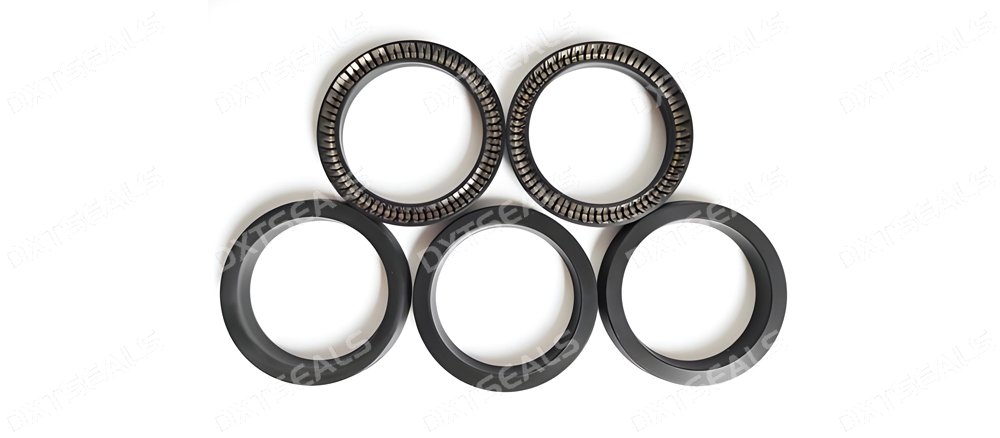
In industrial equipment and machinery that operate under extreme conditions—such as high pressure, high speed, aggressive chemicals, or fluctuating temperatures—a single type of seal may not be enough to deliver reliable performance. That’s where the combination of spring-energized seals (also known as FEA seals) and shaft seals comes into play.
As a leading manufacturer of precision sealing components, DXTSEALS offers innovative sealing solutions that combine these two types of seals to provide maximum sealing efficiency, longer service life, and reduced maintenance for mission-critical applications.
🔍 What Are Spring-Energized Seals and Shaft Seals?
✅ Spring-Energized Seals (FEA Seals)
These seals feature a polymer-based jacket (such as PTFE, UHMWPE, or PEEK) supported by a corrosion-resistant metal spring. The spring maintains consistent radial force, allowing the seal to adapt to pressure variations, thermal expansion, and dynamic motion.
Key Advantages:
-
Excellent chemical and thermal resistance
-
Effective in low-pressure to high-vacuum environments
-
Suitable for reciprocating, rotating, and static applications
✅ Shaft Seals (Rotary Shaft Seals)
Typically made from elastomers like NBR, FKM, or HNBR, shaft seals (or oil seals) are designed to retain lubricant and block contaminants at rotating shaft interfaces.
Key Advantages:
-
Cost-effective sealing for rotary motion
-
Effective barrier against dust, dirt, oil, and moisture
-
Widely used in motors, pumps, and gearboxes
⚙️ Why Combine Spring-Energized Seals with Shaft Seals?
In high-performance machinery, each seal type addresses different challenges. When used together, their complementary strengths enhance sealing performance in ways a single seal cannot.
🔧 Benefits of the Combination:
-
Dual Sealing Protection:
-
The shaft seal prevents lubricant leakage and blocks contaminants.
-
The spring-energized seal withstands temperature and chemical extremes.
-
-
Redundancy for Critical Operations:
-
In safety-critical systems, one seal can back up the other if failure occurs.
-
Reduced risk of sudden equipment failure.
-
-
Improved Pressure Handling:
-
FEA seals handle high-pressure fluctuations.
-
Shaft seals manage moderate pressure in dynamic conditions.
-
-
Extended Seal Life:
-
Lower friction from FEA seal reduces shaft wear.
-
The elastomer shaft seal maintains flexibility over a long duration.
-
-
Customization Options:
-
Both seals can be tailored to material, geometry, and application needs.
-
🏭 Application Scenarios and Use Cases
✅ Oil & Gas Industry
In drilling tools and downhole equipment, combined sealing systems are essential to endure:
-
High pressure (up to 20,000 psi)
-
High temperature (up to 260°C)
-
Abrasive drilling fluids
Example:
A dual-seal configuration with a PTFE spring-energized seal paired with a Viton shaft seal is used in mud motors for enhanced sealing under extreme thermal and chemical stress.
✅ Aerospace Equipment
Flight control systems and actuators benefit from this combination for:
-
Light weight
-
Resistance to aviation fluids
-
Vibration and thermal cycling
Example:
A UHMWPE FEA seal combined with a low-friction rotary shaft seal ensures tight sealing in aircraft hydraulic pumps.
✅ Food and Pharmaceutical Processing
Where hygiene and chemical resistance are crucial, this seal combination offers:
-
FDA-compliant materials
-
Dry-running capability
-
Cleanability
Example:
A PEEK FEA seal provides chemical resistance, while an EPDM shaft seal handles washdown conditions in high-speed mixers.
✅ Cryogenic Systems
In cryogenic valves and pumps, sealing is especially challenging due to extreme cold.
Example:
PTFE spring-energized seals provide reliable sealing in LNG systems, while auxiliary shaft seals keep out contaminants from moving components.
🧩 Design Considerations for Combined Use
When designing a sealing solution with both spring-energized and shaft seals, engineers should consider:
-
Seal orientation and spacing
-
Lubrication strategy between the seals
-
Material compatibility with media and temperature range
-
Dynamic behavior (rotational, reciprocating, static)
-
Pressure differentials across each seal
At DXTSEALS, our technical team provides full support in designing and validating integrated sealing systems using CAD modeling, FEA simulation, and field-tested prototypes.
✅ Conclusion
Combining spring-energized seals and shaft seals is a proven approach for achieving robust, reliable, and long-lasting sealing in demanding industrial environments. These hybrid systems address limitations of individual seal types while delivering optimized performance tailored to specific applications.
Whether you’re designing equipment for aerospace, oil & gas, food processing, or high-speed manufacturing, DXTSEALS has the expertise and production capability to create custom sealing systems that meet your exact specifications.
🔗 Explore our custom sealing solutions today at www.dxtseals.com
📩 Need technical support? Contact our engineers for a tailored recommendation.
